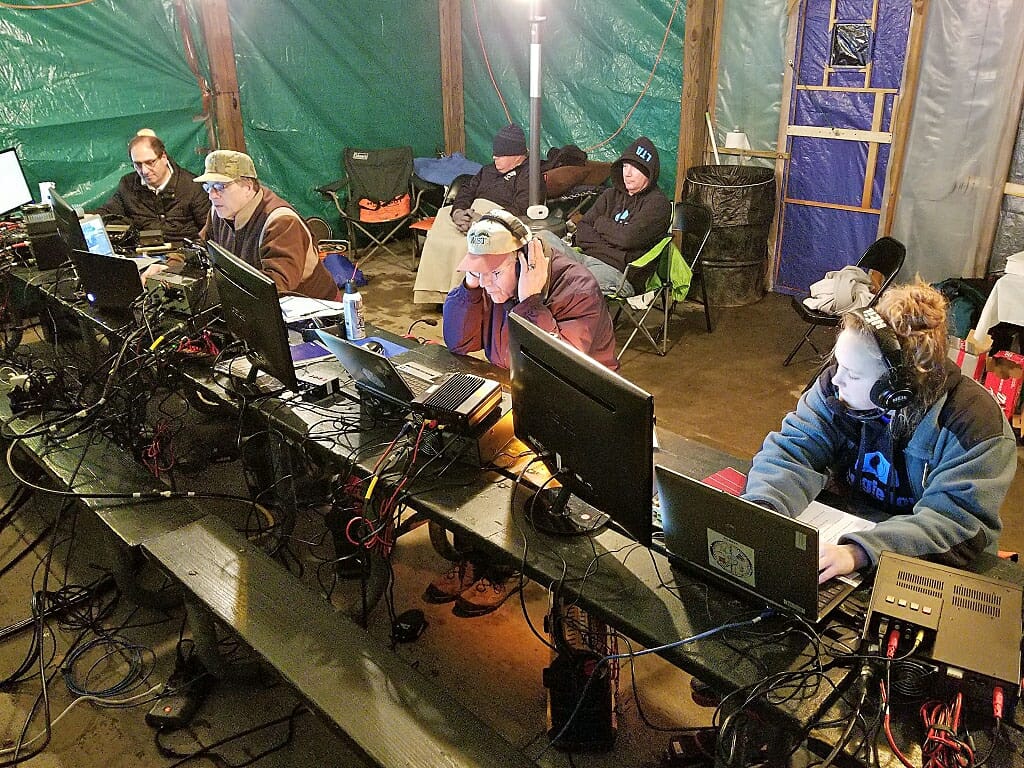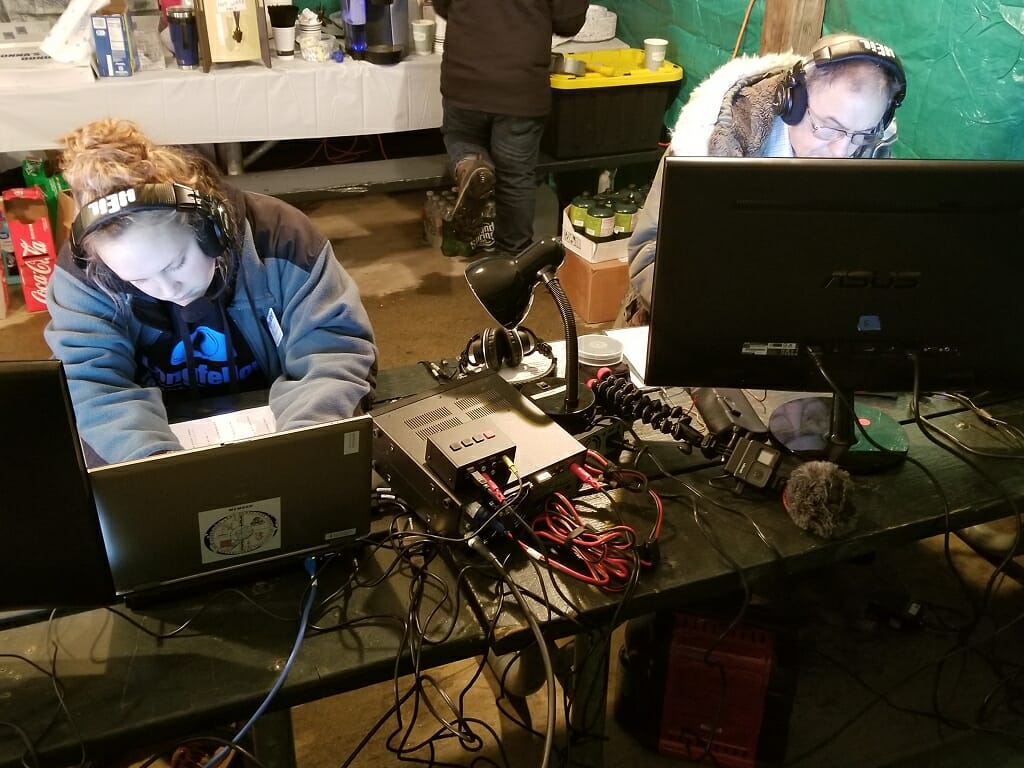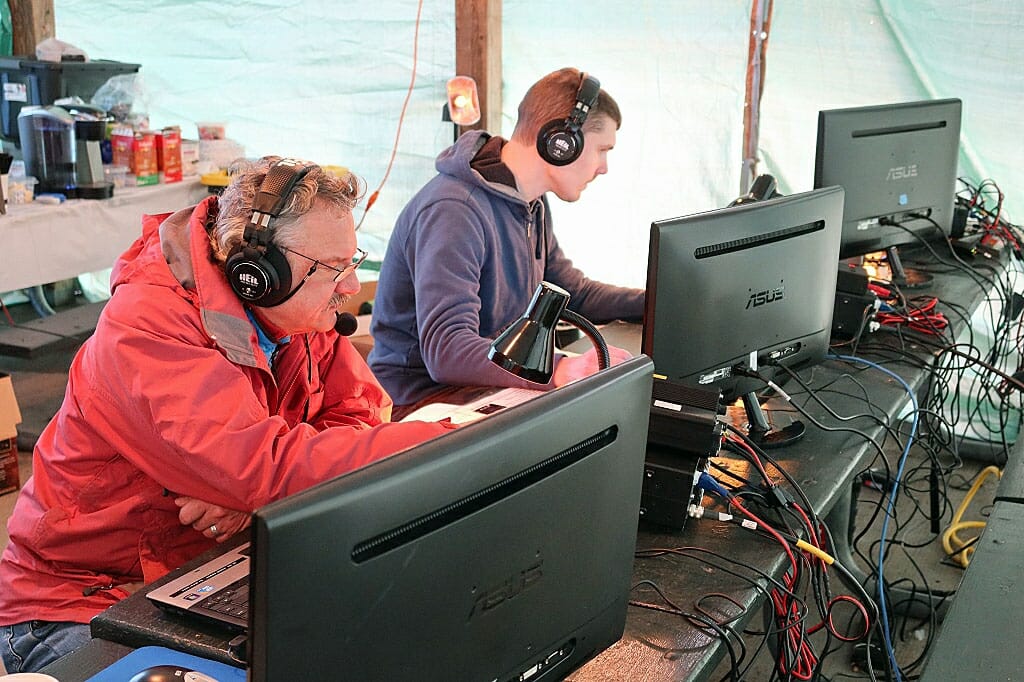We had a great Winter Field Day (WFD) this year! Winter Field Day 2020 provided some real practice and a great chance to develop our Emergency Communications (EMCOM) skills and to get additional practice setting up our towers and antennas.
We operated from Keyes Memorial Park in Milford, NH again in 2020. Keyes provides a great public location, a large open area, and an open pavilion that could be used to construct a temporary outdoor shelter. Jerry K1OKD, Craig, N1SFT, Jon AC1EV, Jamey AC1DC, John KB1EEU, and Fred, AB1OC led the 2019 Winter Field Day Team. Jeff, AC1FX served as our Safety Officer. Also, Anita AB1QB served as the leader of an independent new activity – VHF+ Roving for Winter Field Day.
Winter Field Day Shelter, Heat, Power, and Food

Staying warm, dry, and comfortable is essential for any outdoor operation. This is particularly important for Winter Field Day. John, KB1EEU, Patrick W1YTT, and others handled this very essential and important part of our Winter Field Day 2020 operation by turning the picnic area at Keyes Park into our shelter. They used tarps to close in the area.
The photo above shows our completed shelter. The tarps allow for a small open area at the top to allow for air circulation. This is essential for safety and comfort.
The next step was to set up our generators. Craig, N1SFT handled this task. We use Honda 2000/2200 generators in pairs with external fuel tanks. The setup shown above provides over 10,000 watts of power. The external tanks are a great safety feature. They make refueling a much simpler and safer process.
Jerry K1OKD and others brought heaters that ran on propane and kerosene. The heaters were very effective and kept our shelter at comfortable temperatures all weekend long.

Every army runs on its stomachs! Peter KC1FNF helped us during Winter Field Day 2020 but especially by providing meals and snacks to keep us all going. Thank you, Peter!
Tower And Main HF Antennas
Craig, N1SFT led the tower team. Craig and Team’s great work gave us most of our HF band capability at Winter Field Day 2020. They put up a 40 ft falling derrick tower which supported a tri-band yagi antenna for 20m, 15m, and 10m as well as wire antennas for 40m and 80m.
Our Tower Going Up at Winter Field Day
Check out the video above – it shows our 40 ft falling derrick tower going up at Winter Field Day 2020.

As a result of Craig and Team’s work, we had an excellent antenna system that covered all of the HF bands from 80m through 10m. It really makes a big difference to have directional antennas on 20m – 10m and having our 80m and 40m antennas up nearly 40 ft improve their performance considerably as well.
Building and erecting an antenna system of this type takes considerable engineering knowledge, teamwork, and a very intense focus on safety. Our readers should not attempt this without the proper skills and training and we do not recommend trying to duplicate any of our antenna systems including our falling derrick tower and masts.
Wire Antennas and VHF+ Antennas
Jamey, AC1DC, and Team did a tremendous job with our wire antennas and our VHF+ antennas on our masts. The first to go up was our 160m antenna system. The 160m Transmit antenna is supported by a 50 ft guyed mast. As a result, it is probably the most challenging antenna that we put up during Winter Field Day. Jamey and his team got it up and it produced over 80 KHz of usable bandwidth on 160m.
The team also put up our 160m RBOG receive antenna. The sun had gone down by the time we got to this antenna so we used a generator and our Inter-plexor Beacon Lamp to light the field during the installation.
The combination of these antennas produced an amazing 244 contacts on Top Band!

Jon AC1EV, Andrea KC1JDX and I put up a 40m Delta Loop Antenna. This antenna is a quiet receive antenna and it works on the 40m, 20m (will a tuner), and 15m bands. As a result of this additional antenna, we were able to have two Transceivers on 40m, 20m, or 15m at the same time.
Next up was our 6m antenna which features a 3 element yagi on a 30 ft push-up mast. The team made short work of this antenna. We had a great run on 6m during Winter Field Day. As a result of some more focus on this band, we made a total of 22 contacts on the Magic Band.
The final project of the team was our second VHF+ mast. This one featured yagis for the 1.25m, 33cm, and 23 cm bands. Thanks to the pre-test of this part of our station, it went up very smoothly at Winter Field Day 2020.

The last piece in our VHF+ band antenna puzzle was a portable antenna system for Satellite and 2m/70cm weak signal use. We’ve used these antennas successfully as part of several Field Day operations.
We fed all of our VHF+ antennas with LMR-600 coax which NARS recently added to our kit. As a result, we were able to get most of the 50w – 100w transmit power that our radio generated to the antennas even though some were over 100 ft away.
Winter Field Day’s Awesome Antenna Farm
As a result of all of the hard work of the Tower, Wire, and Mast teams, we had a truly awesome antenna farm for Winter Field Day 2020. Here’s a list of just some of the highlights of the results of everyone’s hard work:
- We had a rotatable directional antenna for 20m – 10m at 40 ft
- We had top-performing wire antennas for 80m and 40m
- We had an amazing portable 160m antenna system that continues to produce a tremendous number of Top Band QSOs with just 100w
- We had a second 40m antenna, a Delta Loop, which enabled us to have multiple transmitters on 40m, 20m, or 15m at the same time
- We had directional antennas for all of the VHF+ bands from 6m – 23cm (1.2 GHz). This included some non-so-often used bands such as 1.25m (220 MHz), 33cm (902 MHz), and 23cm (1.2 GHz).
- Our 2m/70cm antenna system featured computer-controlled rotators and switchable circular polarity making it a breeze to make our satellite contact.
Jamey, AC1DC’s Tour Of Our WFD Antenna Farm
You can click on Jamey, AC1DC’s video above to take a tour of our Winter Field Day 2020 antenna farm.
Stations and Supporting Infrastructure
It takes some significant infrastructure to support a multi-transmitter station of the type that we put together for Winter Field Day 2020.
We brought our Networking Pod which allowed us to connect all of our station computers together using a local ethernet network.
We also used a combination of tri-plexors and band-pass filters to connect our HF transmit antennas to our radios. As a result, multiple transmitters were able to simultaneously use our Tri-Band Yagi and our 40m Delta Loop. In addition, the band-pass filters kept inter-station interference to a minimum.
We had a total of 5 stations simultaneously on the air. This gave our team lots of opportunities to operate. The photo gallery above shows some of our stations. Each station had a dedicated computer with a second monitor running the N1MM+ logger. Our network allowed the station to create a common log which allowed onlookers to see our combined contact totals in real-time.
Jon, AC1EV and I put together our 5 stations and connected them to the network and filter system. This part of our Winter Feild Day 2020 station building project including taking the time to ensure that all of the software which supports functions such as logging, digital operations, CW operations, and our satellite station was working properly. As a result of all of our efforts on station testing before the event, these steps went relatively smoothly.
Our VHF+ stations (which also had HF capability) featured satellite support and provided 50w – 100w on all of the bands from 6m through 23cm. We made good use of transverters to get onto some new bands including 1.25m and 33cm. As a result, we were able to capture many more band-multipliers as compared to last year.
Winter Field Day 2020 Operations
Winter Field Day 2020 operations began at 2 pm on Saturday. The start of operations is always an exciting time. This is a time when we can really determine how well our plans and station building efforts will actually perform.
As a result of everyone’s hard work to prepare and set up our station, we found that our 5O station worked very, very well.
The gallery above shows some of the many folks who operated during Winter Field Day 2020. All of these folks, as well as many others, contributed greatly to what became a record score of us (more on that later).
Our top operators included:
| Operator | Call Sign | QSOs | % of Total QSOs |
|---|---|---|---|
| Dave Pascoe | KM3T | 246 | 22% |
| Marty Sullaway | NN1C | 223 | 20% |
| Abby Finchum | AB1BY | 167 | 15% |
| Bill Noyce | AB1AV | 139 | 12% |
| Dennis Marandos | K1LGQ | 90 | 8% |
| Fred Kemmerer | AB1OC | 76 | 7% |
| Keith Sangillo | KC1IMK | 71 | 6% |
| Other Operators Combined | --- | 121 | 10% |
A special thanks to Dave, KM3T and Marty, NN1C who helped us so much with our operation.
Winter Field Day Young Operators
Winter Field Day 2020 was the first event that is eligible for our Student-Teacher Contest Series. Several of our young members came out to operate in Winter Field Day and to begin working on their entries in the series.
Our young members, as well as other their young people, helped to make our Winter Field Day operation memorable and they contributed greatly to our score.
It’s always great to see our young members operate with parents and friends during an activity like Winter Field Day. This makes for some great fun and creates a learning experience for everyone involved.
How Did We Do?
We posted a record score this year which was more than double that of 2019 Winter Field Day. Here’s a summary of our operating results:
- We had a 5 transmitter Outdoor station (5O) for WFD 2020, adding an additional transmitter over WFD 2019
- We made a total of 1,133 unique (non-duplicate) contacts during the 24-hour operating period
- We worked 46 of the 50 US States
- We worked all but 8 ARRL sections in the US and Canada
- We had an amazing 612 CW, 486 Phone, and 35 Digital Contacts!
- We added a number of bands to our station which enabled us to turn in a solid performance with 35 band-mode multipliers
- Our 160m portable antenna system worked great again this year! We made 244 contacts on 160m using just 100W!
Our final claimed score (after removing duplicates) was:
- Total QSO Points – 1,780
- Power Multiplier (100W or less) – 2
- Band-Mode Multipliers- 35
- Score from QSOs – 124,600
- Outdoor Bonus – 1,500
- No Commercial Power Bonus – 1,500
- Not At Home Location Bonus – 1,500
- Satellite Contact Bonus – 1,500
Final Claimed Score – 130,600
Here’s a breakdown of our contacts by Band and Mode:
| Band | Phone | CW | Digital | Total | % of Total QSOs |
|---|---|---|---|---|---|
| 160m | 2 | 242 | 244 | 21.5% | |
| 80m | 19 | 118 | 7 | 144 | 12.7% |
| 40m | 226 | 108 | 6 | 340 | 30% |
| 20m | 192 | 128 | 9 | 329 | 29% |
| 15m | 3 | 1 | 1 | 5 | <1% |
| 10m | 3 | 1 | 1 | 5 | <1% |
| 6m | 18 | 3 | 1 | 22 | 1.9% |
| 2m | 10 | 3 | 2 | 15 | 1.3% |
| 1.25m | 3 | 2 | 2 | 7 | <1% |
| 70cm | 3 | 2 | 2 | 7 | <1% |
| 33cm | 3 | 2 | 2 | 7 | <1% |
| 23cm | 3 | 2 | 2 | 7 | <1% |
| Satellite | 1 | 1 | <1% | ||
| Totals | 486 | 612 | 35 | 1,133 | 100% |
You can read more about our 2020 Winter Field Day operation on our Blog:
- Winter Field Day 2020 Is Coming
- Winter Field Day 2020 Update
- Winter Field Day 2020 VHF+ Preparations
- VHF+ Station Prep for Winter Field Day 2020
- Winter Field Day 2020 Final Station Test
Additional Field Day highlights and memories can be found in the picture gallery above.
And In The End…
As we always do, we took our Winter Field Day station and antennas down on Sunday at 2 pm after operations ended. The takedown is always a challenge because most of us are tired from a very busy and active weekend. Out Team did a great job with this important step and got all of our gear down and stored during the evening hours.
We had an amazing Winter Field Day this year! Everyone involved worked extremely hard to create our best performance yet, a great experience, and a tremendous learning experience for all involved. Thank you so much to everyone involved for making Winter Field Day 2020 a success!
Fred, AB1OC


























